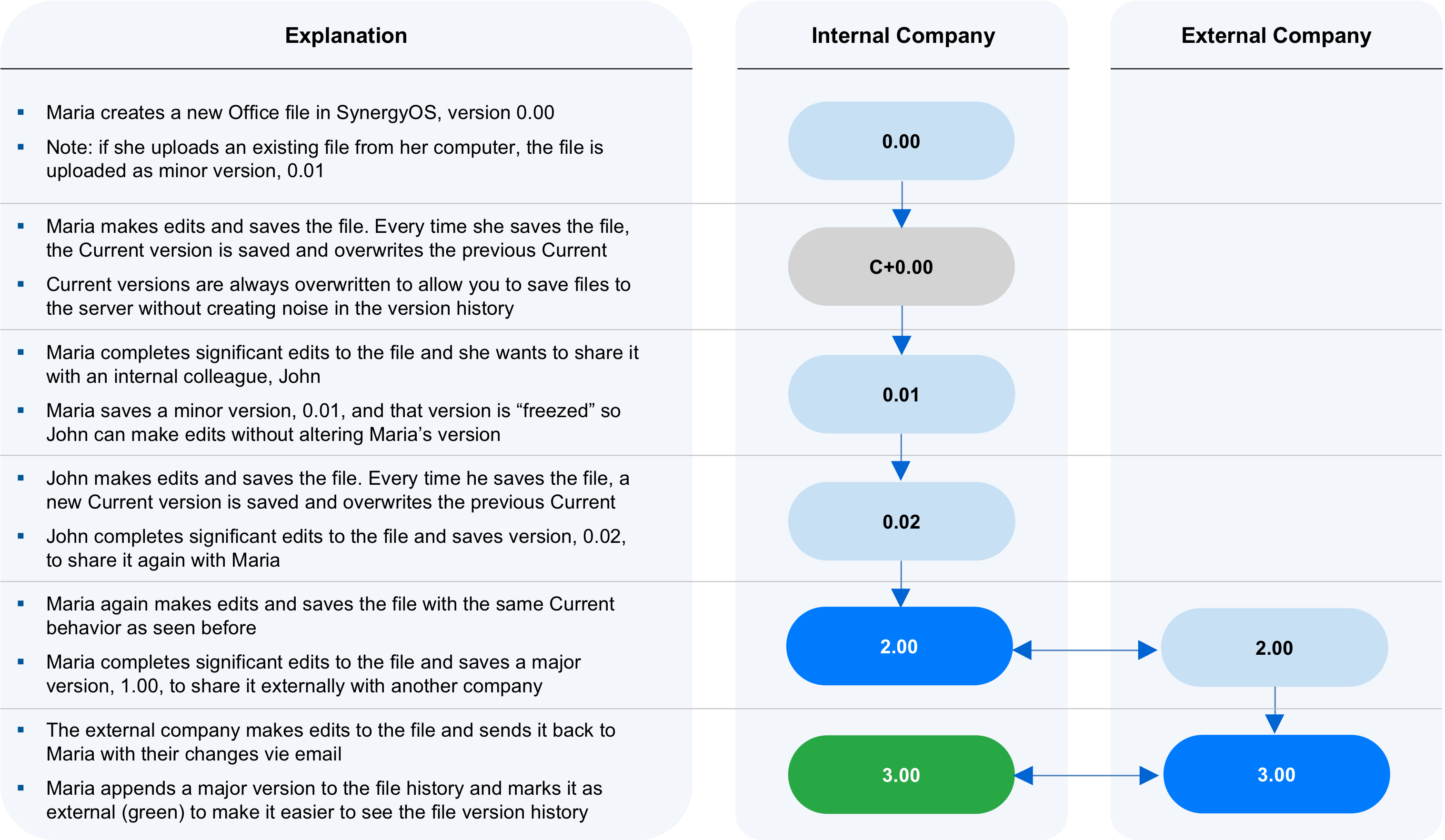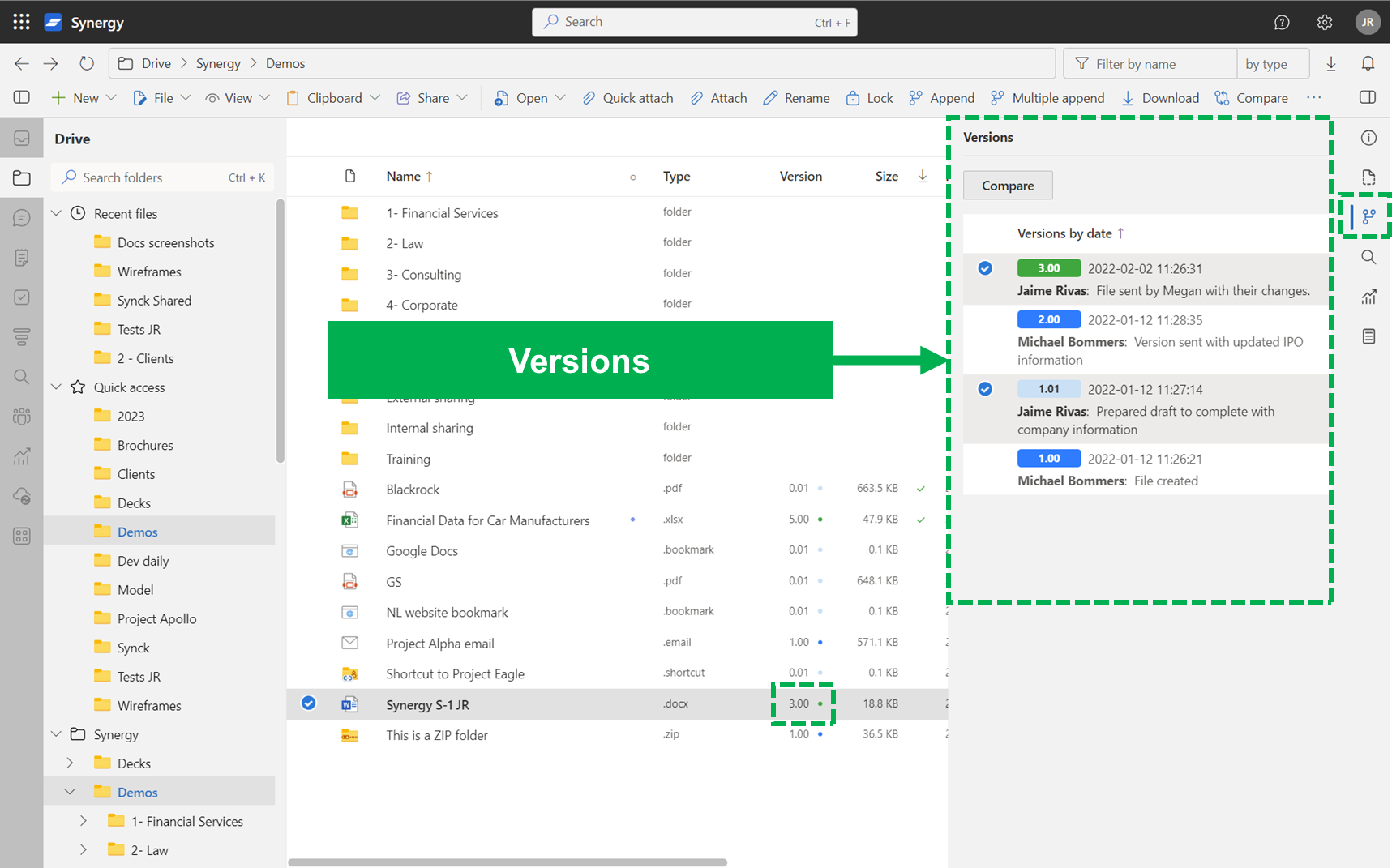File version control
SynergyOS has advanced file version control to provide seamless collaboration with anyone while maintaining file integrity.
The version control system has the following elements:
- File locking: support for both exclusive locks and shared locks
- Current: files in current are overwritten with every file save
- Minor versions: usually represent completion of changes to be shared with people inside your company. It is denoted by the last two digits after the major version number, e.g. version 1.05.
- Major versions: usually represents the completion of significant changes to be shared with people outside of your company. It is denoted by the number before the dot. e.g. version 2.00.
- Overwrite version: option to overwrite the last version to avoid creating file version noise for small changes (some typo or small change that you wanted to include in the version).
Quick explanation of versions

File locking
To resolve the common problem of sync issues and file conflicts, Drive allows you to get an exclusive file lock and stop multiple individuals from editing a file simultaneously, which lies at the root of the problem. Any Microsoft office file that is opened on Drive will be automatically locked. Once you close the file in the Microsoft Office application, the file is automatically unlocked. This is designed to aid your workflow.

It is also possible to lock files "on-demand" when you are not working on Microsoft Office files (for example, to edit a picture with Photoshop). Locking files on-demand is also very useful when working in Offline mode. When you are going to work offline (you are taking a flight or find yourself in a location without internet connection) you may want to lock some files on-demand to avoid version conflicts with others that might also want to work on that file. In those situations we would recommend leaving a comment in the comments field of the file lock so that collaborators are made aware of the context and why the file is locked.
You can also unlock your own files on demand, or use the force unlock function to unlock files from other users. If you force unlock a document, an email notification will automatically be sent to that user.
SynergyOS also support shared file locks to enable co-authoring scenarios. In a shared file lock, users can join an editing sessions. We have enabled shared files locks automatically for Office files opened with Office Online. We also use shared file locks for Office files that you want to edit with SharePoint. In the future, we plan to enable shared file locks for co-authoring scenarios in notes and text files.
Versions
SynergyOS provides version control on all your files. Files can be saved as 3 different versions:
- Current: this is the default method. Files in current are overwritten as soon as you manually choose to save the file. The current then can become a minor or major version
- Minor version: this is typically used when the file has had small changes or it is still work in progress to be shared with people inside your company. It is denoted by the last two digits after the major version number, e.g. version 1.05.
- Major version: usually represents the completion of significant changes to be shared with people outside of your company. It is denoted by the number before the dot. e.g. version 2.00.
- Overwrite version: option to overwrite the last version to avoid creating file version noise for small changes (some typo or small change that you wanted to include in the version).

The Versions tabs shows all the versions of the file. Files can have the following types of versions:
Current
Whenever you open a file on Drive and save your progress, the file will be saved as current by default and be named accordingly. For example, imagine that you open a file that is currently denoted as "version 1.00" and you start editing the file. Once you click save, the file will automatically be saved as "C+1.00". At the same time, a pop-up notification will appear in the right of your screen, which gives you the option of saving a minor or major version.
Each time you repeat the same savings process, the current version will be overwritten, so that there is never more than one current version of the file.
Minor version
Minor versions are denoted by a change in the number after the decimal point. For example, if you make edits to a file that was in "version 1.00" and save your changes as a minor version, Drive will save this new version as "version 1.01". Minor versions are intended to represent smaller or less significant changes to the files. In professional services firms, minor versions are often used as versions or progress updates that are shared with internal team members so they can review, provide comments and make further edits. For every major version you can have up to 99 minor versions (e.g. "Version 1.99").
Major version
Major versions are denoted by the number before the decimal point, and represent the completion of significant changes to a file. In professional services firms, major versions are often used to indicate that significant edits have been completed and that the file is ready to be shared with clients or other external parties.
Overwrite version
In the save version dialog, you have the option to overwrite the last saved version to avoid creating file version noise. This is typically used when, after saving a version, you realize that it needs small changes (you see a typo or realize that forgot something that you wanted to include in the version).